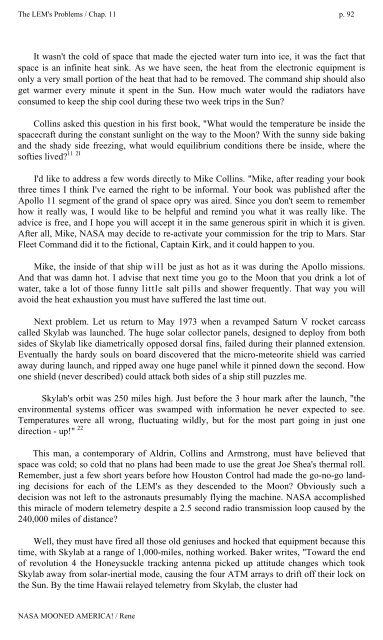Rene-NASA-Mooned-America
Rene-NASA-Mooned-America
Rene-NASA-Mooned-America
You also want an ePaper? Increase the reach of your titles
YUMPU automatically turns print PDFs into web optimized ePapers that Google loves.
The LEM's Problems / Chap. 11 p. 92<br />
It wasn't the cold of space that made the ejected water turn into ice, it was the fact that<br />
space is an infinite heat sink. As we have seen, the heat from the electronic equipment is<br />
only a very small portion of the heat that had to be removed. The command ship should also<br />
get warmer every minute it spent in the Sun. How much water would the radiators have<br />
consumed to keep the ship cool during these two week trips in the Sun<br />
Collins asked this question in his first book, "What would the temperature be inside the<br />
spacecraft during the constant sunlight on the way to the Moon With the sunny side baking<br />
and the shady side freezing, what would equilibrium conditions there be inside, where the<br />
11 2I<br />
softies lived<br />
I'd like to address a few words directly to Mike Collins. "Mike, after reading your book<br />
three times I think I've earned the right to be informal. Your book was published after the<br />
Apollo 11 segment of the grand ol space opry was aired. Since you don't seem to remember<br />
how it really was, I would like to be helpful and remind you what it was really like. The<br />
advice is free, and I hope you will accept it in the same generous spirit in which it is given.<br />
After all, Mike, <strong>NASA</strong> may decide to re-activate your commission for the trip to Mars. Star<br />
Fleet Command did it to the fictional, Captain Kirk, and it could happen to you.<br />
Mike, the inside of that ship will be just as hot as it was during the Apollo missions.<br />
And that was damn hot. I advise that next time you go to the Moon that you drink a lot of<br />
water, take a lot of those funny little salt pills and shower frequently. That way you will<br />
avoid the heat exhaustion you must have suffered the last time out.<br />
Next problem. Let us return to May 1973 when a revamped Saturn V rocket carcass<br />
called Skylab was launched. The huge solar collector panels, designed to deploy from both<br />
sides of Skylab like diametrically opposed dorsal fins, failed during their planned extension.<br />
Eventually the hardy souls on board discovered that the micro-meteorite shield was carried<br />
away during launch, and ripped away one huge panel while it pinned down the second. How<br />
one shield (never described) could attack both sides of a ship still puzzles me.<br />
Skylab's orbit was 250 miles high. Just before the 3 hour mark after the launch, "the<br />
environmental systems officer was swamped with information he never expected to see.<br />
Temperatures were all wrong, fluctuating wildly, but for the most part going in just one<br />
direction - up!" 22<br />
This man, a contemporary of Aldrin, Collins and Armstrong, must have believed that<br />
space was cold; so cold that no plans had been made to use the great Joe Shea's thermal roll.<br />
Remember, just a few short years before how Houston Control had made the go-no-go landing<br />
decisions for each of the LEM's as they descended to the Moon Obviously such a<br />
decision was not left to the astronauts presumably flying the machine. <strong>NASA</strong> accomplished<br />
this miracle of modern telemetry despite a 2.5 second radio transmission loop caused by the<br />
240,000 miles of distance<br />
Well, they must have fired all those old geniuses and hocked that equipment because this<br />
time, with Skylab at a range of 1,000-miles, nothing worked. Baker writes, "Toward the end<br />
of revolution 4 the Honeysuckle tracking antenna picked up attitude changes which took<br />
Skylab away from solar-inertial mode, causing the four ATM arrays to drift off their lock on<br />
the Sun. By the time Hawaii relayed telemetry from Skylab, the cluster had<br />
<strong>NASA</strong> MOONED AMERICA! / <strong>Rene</strong>


